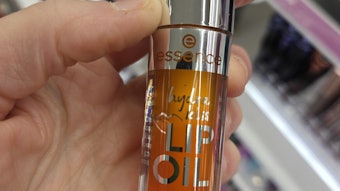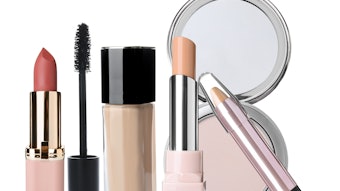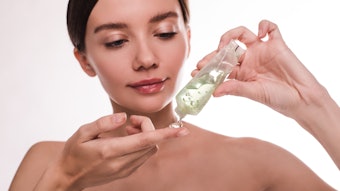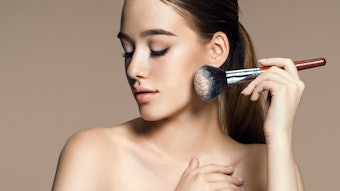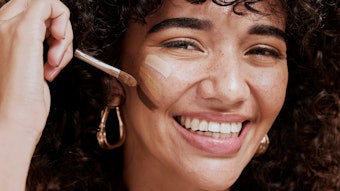Not everyone reacts to the challenges of growing older in the same way. In the case of aging women, in-depth surveys conducted by the authors found that many develop a passive attitude toward makeup over time. The main reason for this is not because they lose interest in using makeup but rather because they are unable to find suitable, natural looking products. This poses the question: Has a lack of R&D for makeup tailored to the needs of elderly women left them unenthused about their makeup choices and thus are they forgoing them entirely?
Modern technology has extended life expectancies; however, individuals desire not only to live longer, but also to maintain a high quality of life as they age. Makeup can help to improve the quality of life in elderly women by providing the appearance of smooth, even-toned skin, in turn improving their emotional well-being. One example targeting this psychological effect is makeup therapy, which is being used more often in hospitals and nursing homes. However, there is still a lack of scientific data for the physiological effects of makeup. Understanding the many nuanced benefits that makeup can provide could encourage elderly women to take a more proactive stance toward its use. Thus, the goals of the present study were to develop a foundation specifically tailored to the needs of elderly women, and to validate via scientific measurements what has been known intuitively—that wearing the right makeup leads to brain activation.
Consumer survey: An in-depth survey was conducted on 30 elderly women, aged 65–83 (avg. age = 73), to measure their attitude toward makeup. Figure 1 shows the results of this survey and indicates that 74% of the women increased or retained an interest in makeup as compared with their earlier years, but 53% reported wearing less of it. Their sense of aging discouraged them from using makeup. When asked to identify their favorite characteristics in the foundation they use, “price” (27%) was cited more often than “finish” (19%). However, the women had specific ideas of the desired finish—a natural look without appearing as though they were wearing makeup.
The authors also interviewed two professional beauticians regarding their experiences with makeup therapy for elderly women and learned that producing a brighter complexion by imparting a natural luster is more important than covering imperfections.
Developing Prototype Formulations
The results of these surveys suggested the need to develop a foundation specifically for elderly women from a highly transparent material with both high diffusion and reflection. Researchers addressed this need by adapting a fiber technology that was originally developed for privacy curtains.1 These special curtains allow as much light to pass through as regular, nonprivacy curtains but are nearly opaque in appearance, as shown in Figure 2.
Materials and Methods
To determine the appropriate materials to apply in the new foundation, a tri-ring spectrophotometera was used to measure light reflected from the interior of a thin layer of different
0.1 g of powder materials premixed with 0.9 g transparent resin. The tri-ring spectrophotometer shown in
Figure 3 has a pen-shaped probe that emits three separate coaxial rings of illumination around the central photo-detector. As the distance between the irradiating ring and the photo-detector increases, the light travels a longer path through the thin layer. The researchers defined and calculated the ratio of the L* values of outside and inside (ROI) as follows:
ROI = L*(o) / { L*(o) + L *(i) } Eq. 1
where L*(o) = the L* value when the light is emitted from outside ring, L*(i) = the L* value when the light is emitted from inside ring. This value was used as an index of the reflected light traveling through the interior of a layer. In addition, a
haze-meterb was used to measure the haze value as an index of diffuseness.
When 30 conventional powder pigments were plotted by haze value versus ROI, the newly developed pigment, which has a platelike shape when viewed from above and a spherical shape from the side, showed properties of both high diffusion (haze value), and high reflection (ROI). It has a low refractive index and a shape resembling four connected columns, as seen in
Figure 4. This technology, made from polyethylene terephthalate (PET), was used in the development of a new powder. The powder is highly transparent and disperses light naturally and effectively. Figure 5 shows measurements of the optical properties of this powder.
Using the data and survey information gathered, researchers formulated a foundation incorporating this highly transparent and diffusive powder material. Subjective evaluations were performed on the same 30 elderly women as previously described. Overall, the prototype foundation incorporating 8% of the new powder was preferred by 79% of the women over a foundation without the powder. Subjects confirmed the effectiveness of the prototype foundation, reporting it felt lustrous (59%), looked natural (45%) and created a brighter complexion (24%) and youthful look (24%) (data not shown).
EEG Analysis of Makeup Efficacy
A 5-min electroencephalogram (EEG) recording was performed with eleven subjects at rest with their eyes closed, before and after makeup application. The makeup application and EEG recordings were performed with regular clients of the Kudoh Chiaki Clinic for Neurosurgery and Neurology in Tokyo, where studies on the effects of art therapy and music therapy on brain activity have been performed. All subjects selected were identified by a physician as having mild cognitive impairment and thus in need of some preventive measures against developing Alzheimer’s disease. EEG recordings were analyzed using the Diagnosis Method of Neuronal Dysfunction (DIMENSION) method, developed by Brain Functions Lab.3, 4 Scalp potential for the EEG alpha-component in a normal subject was well-approximated by a potential distribution generated by an optimal single current dipole generator, and its fittedness (dipolarity), D, is close to 1. Patients in a very early stage of Alzheimer’s disease (AD) behave normally and are sensitive to improvements in brain function. Thus, they are appropriate subjects to observe the effects of brain activation by makeup. Their scalp potential distribution is distorted with local neuronal impairments and when the potential distribution becomes unstable, as shown in
Figure 6. The mean and standard deviation of dipolarity showing smoothness of the scalp potential distribution are denoted as Dα and Dσ, respectively.
The test foundation and other commercial makeup products requested by the subject such as eyebrow pencil and lip rouge were applied by a trained beautician to the eleven women, who had an average age of 77. Results of the DIMENSION analysis were graphed in a fan-beam area on the Dα- Dσ plane, which is divided into normal, sub-normal and impaired regions according to brain activity, as shown in Figure 7.
Results and Discussion
Makeup was applied to the faces of the eleven women as shown in
Figure 8 and subjects observed the changes in their appearance using a mirror. Most individuals reported feeling more beautiful and happy. Figure 9 shows the result of analysis by DIMENSION. Increased brain activity (D of the Da ≥ 0.005) was obtained in seven of the 11 women, as indicated by the arrows. Also, the mean of Da of all 11 women significantly improved after makeup application, as is shown in Figure 10.
Conclusions
Historically, prospective customers of cosmetic companies were thought mainly to be women in their late teens to early 60s. Elderly women either have settled for the foundation they used when they were younger, or they have stopped using makeup due to a lack of appropriate choices. Here, the authors created a foundation targeting the needs of elderly women to provide them with an appropriate choice.
The described product uses a novel fiber technology to provide excellent coverage while maintaining a natural, luminescent appearance. Even more
significant is the observation of measurable brain function improvement with the use of the new foundation and makeup materials, suggesting the possibility that enhancing appearance with makeup could help the elderly resist the loss of mental acuity.
Elderly women who feel beautiful are less likely to retreat into isolation and are more likely to maintain healthy and active relationships with friends.4 Developing a makeup that addresses their needs could help them maintain a positive outlook and increase their quality of life. The encouraging results of these experiments point to an important opportunity for cosmetic companies to cooperate with medical institutions and develop cosmetic products that are truly beneficial to the aged population.
References
1. Japanese patent JP 2007-131985A
2. T Musha et al, A new EEG method for estimating cortical neuronal impairment that is sensitive to early stage Alzheimer’s disease, Clinical Neurophysiology 113 1052-1058 (2002)
3. T Musha et al, Localization of impaired cortical neurons by EEG power fluctuation analysis, International Congress Series 1270 20-25 (2004)
4. M Nagatomo et al, Relation between makeup actions and affect revelation. For demented elderlies, J of the Japanese Psychiatric Nursing Society 40(3) 43-46 (1997)

